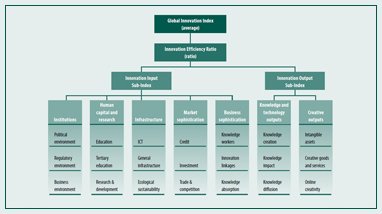When it comes to innovation, the top 25 countries are the same you would normally expect – but ranked in a slightly different order – nevertheless this year’s Global Innovation Index , produced by INSEAD, WIPO and Cornell University highlights the fact that there is no short-cut to innovation. What are the right ingredients? It takes a mix of talent, sustained investment, institutional support and the right mindset necessary to get to the top.
The United States re-entered the charts amoung the top five most-innovative nations and the United Kingdom moved up to the third spot while Switzerland retained its place atop the rankings in the Global Innovation Index 2013. The US was last seen in the GII top 5 in 2009, when it came in at number one. This is how it works; The index ranks 142 world economies using 84 indicators seen as reflecting “innovation capabilities,” as well as actual innovation. To qualify for for invention, variables like political stability, the availability of education, and regulatory environment are considered. To measure output, they noted new patents, exports, and scientific and technical journal articles.
Despite the economic crisis, innovation is alive and well. Research and development spending levels are surpassing 2008 levels in most countries and successful local hubs are thriving. A group of dynamic middle- and low-income countries – including China, Costa Rica, India, and Senegal – are outpacing their peers, but haven’t broken into the top of the GII 2013 leader board.
This year’s report casts additional light on the local dynamics of innovation, an area which has remained under-measured globally. It shows the emergence of original innovation eco-systems, and signals a needed shift from a usual tendency to try and duplicate previously successful initiatives.
“Dynamic innovation hubs are multiplying around the world despite the difficult state of the global economy. These hubs leverage local advantages with a global outlook on markets and talent.” said WIPO Director General Francis Gurry. “For national-level policy makers seeking to support innovation, realizing the full potential of innovation in their own backyards is often a more promising approach than trying to emulate successful innovation models elsewhere.”
A review of the report by ipkitten finds that the report has some elements missing:
“The report assiduously avoids controversial areas, such as the ‘brain drain’ suffered by many developing countries. It also fails to ask deeper questions about what the purpose of innovation should be in any given country, and the extent to which innovation should be focused on solving the dominant problems there. Perhaps there are situations in which innovation would not be best way to promote economic growth. The data in the report provides no way of assessing the stimulus to the economy that could be provided by innovation compared to other stimuli, such as building more roads, for example”.
In my opinion, there is a broad range of criteria used in the report, with the support brought to innovation by public institutions, the human capital, R&D infrastructure, market and business sophistication as well as the actual innovations themselves all being well accounted for. Among the encouraging signs identified by GII 2013, 18 emerging economies are outperforming other countries in their respective income groups in order of distance: the Republic of Moldova, China, India, Uganda, Armenia, Viet Nam, Malaysia, Jordan, Mongolia, Mali, Kenya, Senegal, Hungary, Georgia, Montenegro, Costa Rica, Tajikistan and Latvia. All of them demonstrate rising levels of innovation compared with their peers.
Even if progress is not uniform, this is a result of tackling the formulation of a good policy-mix on all meaningful fronts: institutions, skills, infrastructures, integration to global markets and linkages with the business community.
To download the full report, visit: www.globalinnovationindex.org

Hayden Richards is Contributor of IntelligentHQ. He specialises in finance, trading, investment, and technology, with expertise in both buy-side, sell-side. Contributing and advising various global corporations, Hayden is a thought leader, researching on global regulatory subjects, digital, social media strategies and new trends for Businesses, Capital Markets and Financial Services.
Aside from the articles, interviews and content he writes for IntelligentHQ, Hayden is also a content curator for capital markets, analytic platforms and business industry emerging trends. An avid new media explorer Hayden is driven by a passion for business development, innovation, social business, Tech Trading, payments and eCommerce. A native Trinidadian, Hayden is also a veteran, having served with the Royal Air Force Reserves for the past 10 years.
Follow Hayden on Twitter @HaydenARichards, linkedin.com/haydenhrichards and http://www.scoop.it/u/hayden-richards












